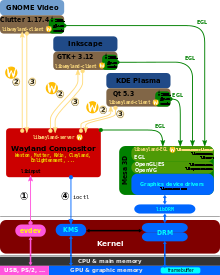Window system



A window system ( English windowing system ) is the base of a graphical user interface (GUI), whose main task managing program windows is. It is usually part of a larger desktop environment .
From the point of view of a programmer , the window system implements the basic graphic functions such as displaying fonts , drawing lines, curves and pixel graphics, and abstracting the graphics hardware ( graphics card ).
The window system allows the user to work with several programs at the same time by executing each program "in" one or more separate areas of the screen , the windows, which are usually rectangular , can be moved freely with the pointing device ( mouse ) and each other may overlap.
Some window systems, such as the X Window System in Unix-like environments, have advanced capabilities such as network transparency that allow the user to display the graphical interface of an application on another computer. The X Window System also does not implement a fixed appearance of the environment, which means that the window managers , GUI toolkits and desktop environments have complete freedom in terms of visual design and handling.
List of window systems
- 8½ and rio for plan 9
- GEM
- PC / GEOS ( G raphic E nvironment O perating S ystem, the window system for Commodore 64 and 128)
- Fresco / Berlin
- FBUI
- Qt Extended (formerly Qtopia )
- Quartz Compositor for macOS
- X Window System (Free Software, the de facto standard in Linux and other Unix -like operating systems )
- Wayland
- Me
- Windows Presentation Foundation
- Xynth
- ManaGeR (MGR)
- Twin ( T ext Win dow Manager)
- Window systems for the web: